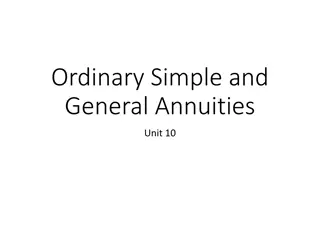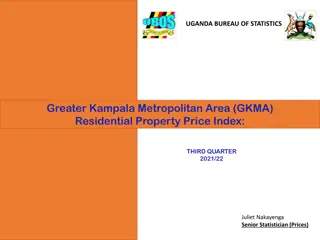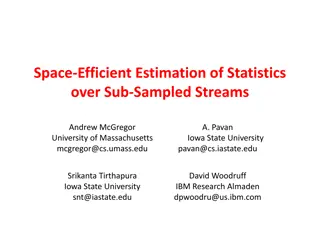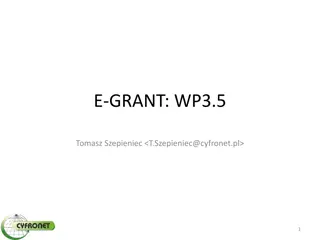EE 303 Energy Systems and Power Electronics
Explore the world of power electronics through topics like DC-DC converters, buck converters, boost converters, duty ratio calculations, and more. Learn how to analyze and compute various aspects of power systems for efficient energy management.
0 views • 19 slides
Secure Your Cloud with Confidence Defend against Threats with Microsoft Sentinel
Explore the powerful combination of Jupyter Notebooks and Microsoft Sentinel for efficient threat hunting and defense against cyber threats. Learn how to set up your Azure ML workspace, assign compute resources, and store investigation artifacts for enhanced response capabilities.
4 views • 45 slides
Understanding Linux Process Scheduling and Priorities
Delve into the intricacies of process scheduling in Linux systems, covering topics such as task prioritization, process states, scheduler decisions, and important scheduling scenarios. Learn about traditional scheduling concerns like throughput and latency, as well as different types of workloads su
1 views • 19 slides
Understanding Different Types of Scripts in HEC-ResSim
Explore the two main categories of scripts in HEC-ResSim - scripts executed outside simulations and scripts executed during simulations. Learn about the functions and properties of each type, including scripted rules and state variable scripts. Discover how these scripts compute flow limits, store m
5 views • 23 slides
Understanding Binomial Distribution in R Programming
Probability distributions play a crucial role in data analysis, and R programming provides built-in functions for handling various distributions. The binomial distribution, a discrete distribution describing the number of successes in a fixed number of trials, is commonly used in statistical analysi
14 views • 30 slides
Understanding Amazon EC2: Elastic Compute Cloud Fundamentals
Amazon Elastic Compute Cloud (EC2) is a web service provided by Amazon Web Services (AWS) that offers resizable compute capacity in the cloud. EC2 allows users to rent virtual servers known as instances to run applications. Key features include various instance types, Amazon Machine Images (AMIs), s
11 views • 5 slides
Understanding FELIX Phase II Run 4 and Versal Prime ACAP Device
Explore the advancements in FELIX Phase II Run 4, leveraging Xilinx Versal Prime ACAP Device, showcased at the 3rd CERN System-on-Chip Workshop. Witness massive improvements in trigger rates, data readout rates, and interactions per bunch crossing. Dive into the hardware details and Versal Prime's c
2 views • 36 slides
Physics 2BL Laboratory: Measurements, Error Analysis & Data Interpretation
This Physics 2BL laboratory course focuses on measurements of physical quantities, error analysis, and interpretation of data. Students learn how scientists create models of natural phenomena and the practical aspects of conducting scientific experiments. Pre-requisites include Physics 2A, 4A or equ
0 views • 31 slides
Understanding Natural Resources and Resource Economics
Economics of natural resources focuses on the supply, demand, and sustainable allocation of the Earth's resources. It aims to develop a sustainable economy that protects natural resources for future generations. Natural resources are essential for human survival and include biotic and abiotic resour
0 views • 11 slides
Advanced Cooling Solutions for Immersion Servers by Asperitas
Asperitas offers an innovative immersion cooling solution for servers, featuring the AIC24-15/19/21 technology with advanced power and compute densities. The integration solution includes power delivery, management, cooling, monitoring, and containment features for optimal performance. Their Shell I
1 views • 19 slides
Understanding Tax Tables, Worksheets, and Schedules for Federal Income Taxes
Explore the concept of tax tables, worksheets, and schedules for calculating federal income taxes. Learn how to express tax schedules algebraically and compute taxes using IRS resources. Examples featuring single and married taxpayers provide practical insights into determining taxable income and ca
0 views • 11 slides
Understanding Income Tax in India: Gross vs Total Income
In India, income tax is calculated based on the total income or taxable total income. The gross total income includes earnings from all sources like salary, property, business, and capital gains. Various additions such as clubbing provisions, adjustments for losses, unexplained credits, investments,
0 views • 7 slides
Understanding Annuities: Types and Examples
An annuity is a series of equal payments made at regular intervals, with examples including mortgages, car loans, and student loan payments. Different types of annuities include simple and general annuities, ordinary annuities, deferred annuities, perpetuities, and annuities certain. Learn to comput
0 views • 31 slides
Understanding Combinations and Probability in Statistics
Explore the concept of combinations and probability in statistics with a focus on calculating the number of ways to choose individuals from a group without considering order. Learn how to compute combinations, apply counting principles, and solve practical examples to deepen your understanding.
0 views • 18 slides
Bivariate Normal Data Analysis: LPGA 2008 Season Overview
Explore the analysis of bivariate normal data focusing on LPGA driving distance and fairway percent from the 2008 season. Learn how to compute confidence ellipses, estimated means, variance-covariance matrix, eigenvalues, eigenvectors, and plot insightful visualizations. Understand the method, set u
1 views • 8 slides
Residential Property Price Index for Greater Kampala Metropolitan Area Q3 2021/22
The Uganda Bureau of Statistics presents the Residential Property Price Index (RPPI) for Greater Kampala Metropolitan Area in the third quarter of the financial year 2021/22. The RPPI covers Kampala and Wakiso districts, utilizing the hedonic pricing approach to compute price factors influencing res
0 views • 8 slides
Understanding Business Organization Objectives
Explore the basic vocabulary of business organizations and learn how to compute financial responsibilities based on ratios and percents. Discover different business structures such as sole proprietorship, partnership, and corporation, and delve into concepts like shares of stock, shareholders, and l
0 views • 9 slides
Understanding the Need for Neural Network Accelerators in Modern Systems
Neural network accelerators are essential due to the computational demands of models like VGG-16, emphasizing the significance of convolution and fully connected layers. Spatial mapping of compute units highlights peak throughput, with memory access often becoming the bottleneck. Addressing over 300
0 views • 21 slides
Understanding the Multiplication Counting Principle in Probability
The Multiplication Counting Principle and Permutations play a crucial role in determining the number of possible outcomes in various processes. This lesson covers how to use factorials to count permutations, compute arrangements of individuals, and apply the multiplication counting principle to dete
0 views • 14 slides
Understanding Income Tax Law and Practice with Dr. C. Saffina
Dive into the realm of Income Tax Law and Practice hosted by Dr. C. Saffina, Assistant Professor of Commerce, as the concept of income from other sources is explained. Explore what is taxable income, such as dividends, interest on securities, and winnings from gambling, and learn how to compute inco
0 views • 14 slides
Understanding Loop Structures in Python Programming
This lecture covers Loop Structures, specifically focusing on the while statement and nested loops in Python programming. It discusses the Fibonacci sequence and demonstrates how to write a program to compute the nth Fibonacci number. Additionally, it explains the difference between definite and ind
3 views • 22 slides
Understanding the Residue Theorem in Complex Analysis
The Residue Theorem is a powerful tool in complex analysis that allows us to evaluate line integrals around paths enclosing isolated singularities. By expanding the function in a Laurent series, deforming the contour, and summing residues, we can evaluate these integrals efficiently. This theorem ex
0 views • 31 slides
Understanding Diffie-Hellman Key Exchange Algorithm
The Diffie-Hellman key exchange algorithm, a pioneering public-key cryptography method introduced by Diffie and Hellman in 1976, enables secure key exchange between two users to facilitate subsequent message encryption. The algorithm relies on the complexity of computing discrete logarithms and invo
0 views • 24 slides
Intel Software OneAPI Level Zero Sysman Overview
Introducing Intel Software OneAPI Level Zero Sysman, a powerful API that provides fine-grained control over accelerator devices, offering features such as monitoring power profiles, controlling device performance, and managing peer-to-peer interconnects. With a focus on security and flexibility, Lev
0 views • 24 slides
Revolutionizing Enterprise Datacenters with Open Compute Hardware Community
The Open Compute Project Foundation, a non-profit open-source community, is disrupting the traditional data center industry by eliminating overkill in enterprise data centers through innovative hardware designs and collaborative contributions. OCP's technology principles focus on efficiency, scalabi
1 views • 25 slides
Insights into the OCP Market & Supply Chain Growth Trends
Explore key growth trends in the Open Compute Project (OCP) market and supply chain, including the move towards open source solutions, significant increases in worldwide server revenue and shipments, and the expanding data center market in the rest of Asia. Discover the reasons behind the adoption o
1 views • 25 slides
Secure Multiparty Computation: Enhancing Privacy in Data Sharing
Secure multiparty computation (SMC) enables parties with private inputs to compute joint functions without revealing individual data, ensuring privacy and correctness. This involves computations on encrypted data using techniques like homomorphic encryption for scenarios like e-voting. SMC serves as
2 views • 27 slides
Overcoming Memory Constraints in Deep Neural Network Design
Limited availability of high bandwidth on-device memory presents a challenge in exploring new architectures for deep neural networks. Memory constraints have been identified as a bottleneck in state-of-the-art models. Various strategies such as Tensor Rematerialization, Bottleneck Activations, and G
0 views • 32 slides
Chemical Kinetics and Numerical Solvers in Chemistry
Explore the principles of chemical kinetics and the use of numerical solvers to compute concentrations over time, considering explicit and implicit methods. Understand stability and positivity requirements in solvers and the importance of characteristic time scales in chemical systems. Dive into a s
0 views • 5 slides
Space-Efficient Estimation of Statistics Over Sub-Sampled Streams
This research focuses on efficiently estimating statistics over sub-sampled streams, particularly in the context of IP packet streams for traffic monitoring. Various types of sampling methods are explored, such as Bernoulli sampling, to compute key metrics like frequency moments, number of distinct
0 views • 22 slides
Understanding the Key Articles of the Nagoya Protocol on Access to Genetic Resources and Benefit-Sharing
The Nagoya Protocol aims to promote fair sharing of benefits from genetic resources utilization for conservation efforts. It encompasses access, technology transfer, funding, and respect for rights over resources and technologies. The protocol applies to genetic resources, traditional knowledge, and
1 views • 19 slides
Compute and Storage Overview at JLab Facility
Compute nodes at JLab facility run CentOS Linux for data processing and simulations with access to various software libraries. File systems provide spaces like /group for group software, /home for user directories, and Cache for write-through caching. Additionally, there are 450TB of cache space on
0 views • 11 slides
Understanding Natural Resources: Types and Conservation
Natural resources play a crucial role in sustaining life on Earth, encompassing elements like water, air, soil, minerals, and more. These resources can be classified into renewable and non-renewable categories, with the former being replenishable through natural cycles and the latter being finite an
0 views • 24 slides
Insights into Loop Optimization and Hardware Specialization with HLS
Learn about loop optimization and hardware specialization with High-Level Synthesis (HLS) from the expertise of Assistant Professor Callie Hao at Georgia Institute of Technology. The content covers topics such as array partitioning, memory parallelism, performance gains through specialization, and t
0 views • 46 slides
Confidence Intervals and Interval Estimation in Statistics
Understanding how to compute confidence intervals is crucial in statistics to estimate parameters accurately. Confidence intervals are constructed based on sample size, mean estimate, estimated standard error, and chosen level of confidence. Using the Student-T distribution for sampling distribution
0 views • 14 slides
E-GRANT: Resource Allocation Tool Features and Development
E-GRANT is an advanced resource allocation tool developed by EGI-Engage for efficiently managing resources allocation for projects related to computing, storage, and VMs. The tool allows customers to send requests, negotiate resources, sign SLAs, and view allocations. It also enables resources provi
0 views • 5 slides
Leveraging Resources in FY 2021 IHBG Competitive Grant Application
The FY 2021 IHBG Competitive Grant Application emphasizes Leveraging Resources as Rating Factor 4, where applicants can earn up to 5 points based on the percentage of leveraged resources relative to project costs. Firm commitments through cash or in-kind donations are encouraged, with examples inclu
0 views • 31 slides
HNSciCloud and VMDIRAC Project Overview
The HNSciCloud and VMDIRAC project aims to create a common hybrid science cloud platform for the European research community, addressing challenges in compute, storage, data management, network connectivity, and identity services. Current activities involve solution prototyping, pilot deployments, a
0 views • 9 slides
Understanding SDN and OpenStack in Cloud Computing
SDN in OpenStack enables innovation, accelerates new features and services, and simplifies provisioning. OpenStack is an open-source cloud software collection with tenant-facing APIs for consuming cloud services. OpenStack services include Compute, Block Storage, Object Storage, Images, and Network
0 views • 14 slides
Understanding Parallel Processing Fundamentals
This overview delves into the basics of parallel computing, covering parallel memory architectures, programming models, design issues, and parallelizing serial programs. Parallel computing involves leveraging multiple compute resources simultaneously to enhance computational efficiency and solve pro
0 views • 35 slides







































